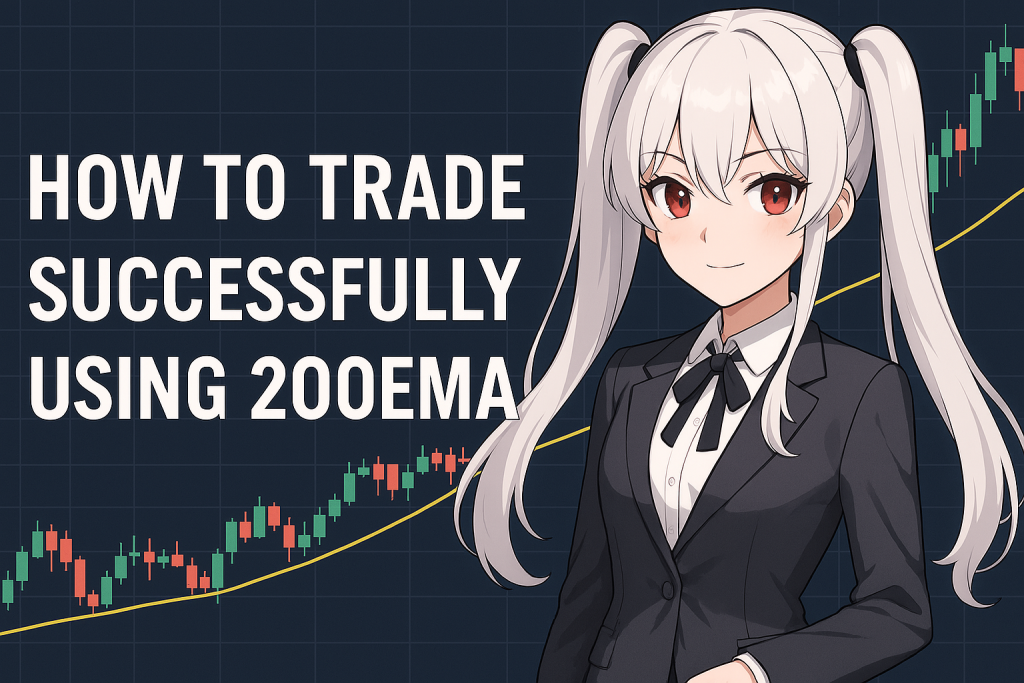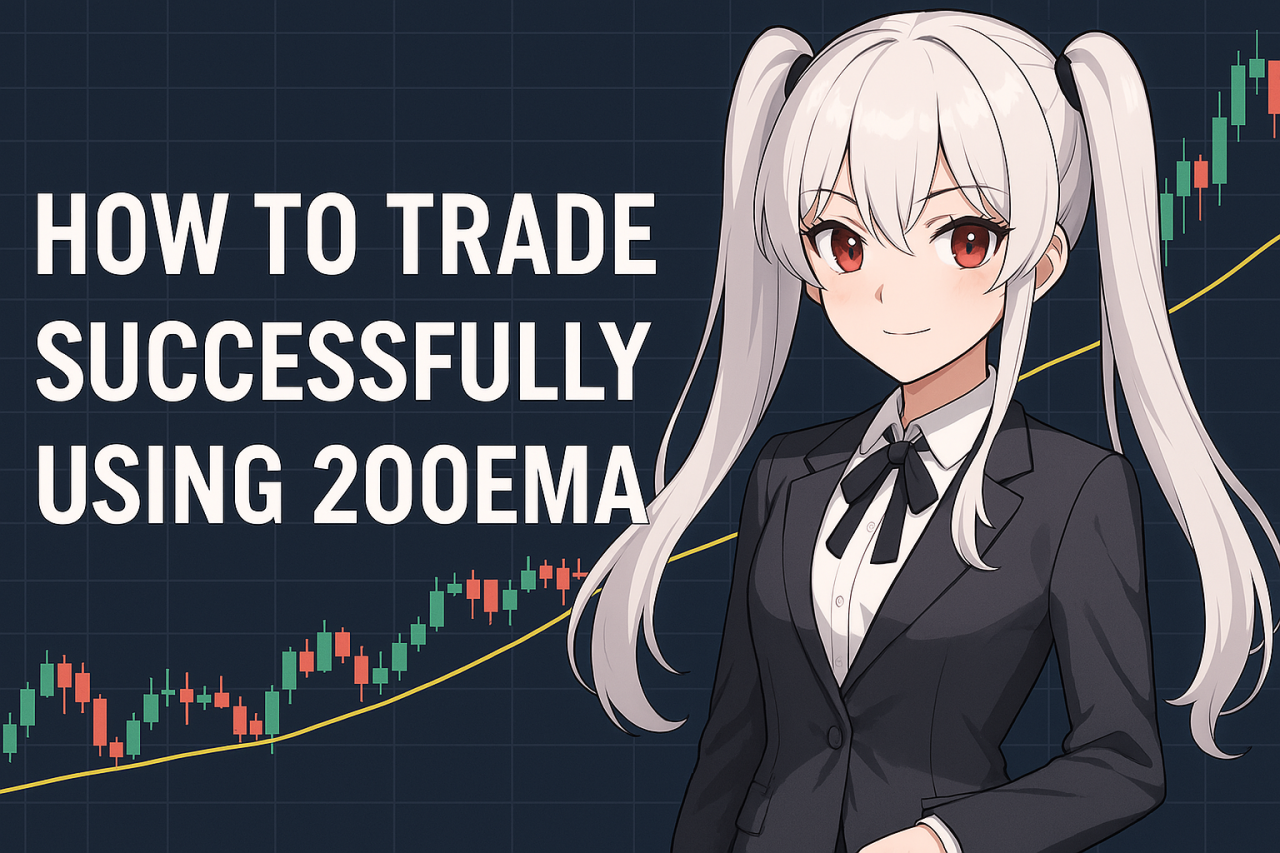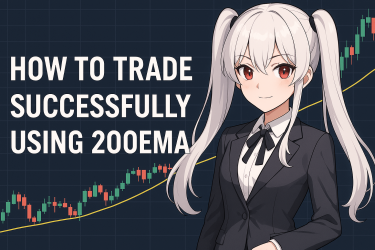In FX and stock trading, effectively using technical indicators is extremely important. Among them, the 200EMA is one of the indicators that many traders focus on. This blog introduces a wide range of knowledge about the 200EMA, from its basic concepts to actual trading strategies, and even how to combine it with other indicators. Packed with tips for using the 200EMA effectively, from beginners to advanced traders.
- 1 1. What is 200EMA? A Basic Explanation for Beginners
- 2 2. Why Traders Focus on the 200 EMA
- 3 3. How to View Trading Signals Using 200EMA
- 4 4. Chart-Specific! Effective Ways to Use the 200EMA
- 5 5. Techniques for Combining 200EMA with Other Indicators
- 6 Summary
- 7 Frequently Asked Questions
- 8 Reference Sites
1. What is 200EMA? A Basic Explanation for Beginners
200EMA (200‑period Exponential Moving Average) is one of the most important technical indicators in FX and stock trading. We explain its basic concepts and characteristics in detail so that even beginners can understand.
Basic Concept of 200EMA
200EMA is a moving average calculated from price data over the past 200 periods, giving more weight to recent price movements so it reflects current data more strongly than older data. Because of this characteristic, it is widely used as a reliable indicator for identifying trends.
How to Calculate 200EMA
The calculation method for 200EMA is as follows.
- Calculating the initial EMA: Calculate the simple moving average (SMA) for the first period (here, 200 periods). This becomes the initial EMA value.
- Calculating EMA for Each Period: After that, for subsequent periods, calculate EMA using the following formula.

Here, (k) is the smoothing factor calculated using a period of 200, which equals 0.059.
Features and Advantages of 200EMA
- Identifying Trends: 200EMA is a clear indicator for determining uptrends and downtrends. If the price is above the 200EMA, it indicates an uptrend; if below, a downtrend.
- Support and Resistance: Because many traders pay attention to it, 200EMA also functions as a support and resistance level. Prices often rebound when they approach the 200EMA.
- Long‑Term Perspective: 200EMA is suitable for analyzing long‑term trends and can be used in various strategies from scalping to swing trading.
Differences Between 200EMA and Other Moving Averages
200EMA reflects longer‑term price trends compared to other moving averages (e.g., 50EMA or 100EMA). Generally, long‑term moving averages help grasp the overall market trend, while short‑term moving averages are important for capturing short‑term price movements.
Why Traders Emphasize 200EMA
Traders emphasize 200EMA because of its simplicity and effective trend‑analysis capability. Additionally, because many market participants worldwide use 200EMA, it functions as a psychological support and resistance level. Therefore, by being aware of the position of 200EMA, traders can devise effective trading strategies.
2. Why Traders Focus on the 200 EMA
The 200 EMA (200-period exponential moving average) is considered an essential indicator for many traders. The reasons are mainly trend identification, support and resistance assessment, and understanding market psychology.
Understanding the Trend
The 200 EMA is a powerful tool for indicating long-term trends. When this moving average is upward sloping, it is generally considered an uptrend; when it slopes downward, it is seen as a downtrend. Recognizing this trend is the first step in building an effective trading strategy.
- Trend Visualization: When the price exceeds the 200 EMA, it functions as a buy signal; conversely, when it falls below, it becomes a sell signal.
- Trend Sustainability: The 200 EMA serves as a benchmark for traders to assess the persistence of a trend.
Assessing Support and Resistance
The 200 EMA provides potential support and resistance levels where price may rebound. Because many traders use this indicator, prices often bounce when approaching the 200 EMA. Leveraging this characteristic can lead to higher win rates in trades.
- Confirming Rebound: If price rebounds at the 200 EMA, traders should consider this point as a support or resistance level.
- Market Direction: When the 200 EMA is flat, it may indicate a weakening trend and could signal a market turning point.
Understanding Market Psychology
Because many traders reference the 200 EMA simultaneously, its importance increases. Traders expect price to rebound at the 200 EMA, which makes rebounds more likely. This helps in grasping the overall market psychology.
- Collective Psychology: When many traders focus on the 200 EMA, that level becomes an important point for market participants.
- Trade Concentration: When price reaches near the 200 EMA, trading volume tends to increase, which can make price movements more pronounced.
In Summary
The 200 EMA is valued as a tool for determining long-term trends, identifying support and resistance levels, and understanding trader psychology. This lays the foundation for building effective trading strategies. Because many traders use this indicator, its effectiveness is relatively amplified.
3. How to View Trading Signals Using 200EMA
200EMA (200-day exponential moving average) is a highly valuable indicator for traders. This section provides a detailed explanation of how to view trading signals using the 200EMA.
Basic Trading Signals
200EMA is widely used as an indicator of the trend in stock prices and currency rates. Specifically, it provides the following signals.
- Buy Signal: When the rate is above the 200EMA, it is judged that an upward trend is likely to continue, and a buy position is considered.
- Sell Signal: When the rate is below the 200EMA, it is judged that a downward trend is likely to continue, so a sell position is considered.
By utilizing such signals, you can improve the accuracy of your trades.
Signal Generation Mechanism
Viewing signals based on the 200EMA includes confirming the direction of the trend. Please pay attention to the following points:
- Trend Reversal Point: Situations where the price breaks above or below the 200EMA may suggest a trend reversal. For example, if the price breaks above the 200EMA, it could signal the start of an upward trend.
- Combining with Dow Theory: By combining the 200EMA with Dow Theory, you can assess the strength of the trend. It is important to observe whether higher highs are being set or lower lows are being broken.
Techniques to Add Reliability to Signals
To add further reliability to 200EMA signals, you can combine them with other indicators. Below are examples of indicators that are effective when used in combination.
- RSI (Relative Strength Index): In addition to the 200EMA, using the RSI allows you to confirm overbought or oversold conditions. In particular, if the RSI is 70 or higher, you should treat buy signals with caution.
- MACD (Moving Average Convergence Divergence): A MACD crossover can confirm the 200EMA signal. When both point in the same direction, the probability of a successful trade increases.

Key Points
Finally, there are the following key points to consider when viewing trading signals using the 200EMA.
- Entry Timing: After a signal is generated, it is important not to rush into entry but to consider other confirmation factors.
- Setting Stop Loss: If the signal’s reliability is low, make sure you prepare to set a stop loss early.
By understanding and practicing these strategies, you can conduct more effective trades using the 200EMA.
4. Chart-Specific! Effective Ways to Use the 200EMA
1. Determining the Trend
The 200EMA is highly effective for visually grasping the trend. When the price is above the 200EMA, it can be judged that an upward trend is forming. Conversely, if the price is below the 200EMA, it is likely that a downward trend is continuing. This helps clarify the direction when formulating a trading strategy.
- Upward Trend:
- Price is positioned above the 200EMA
- Can also act as support
- Downward Trend:
- Price is positioned below the 200EMA
- Often acts as resistance
2. Using Support and Resistance
The 200EMA can also function as a support or resistance line. For example, during an upward trend, when the price touches the 200EMA, it often rebounds and rises again. By leveraging this movement, you can find entry points.
- Rebound Points:
- When the price approaches the 200EMA, past data suggests a rebound can be expected
- If the price breaks the 200EMA, it may signal a trend reversal
3. Assessing Volatility
In highly volatile markets, the 200EMA reacts sensitively to price movements. Especially when sharp price moves occur, the 200EMA captures those changes, giving traders a chance to react quickly.
- High Volatility Situations:
- During rapid price spikes or drops, trading with the 200EMA in mind can reduce risk
- Pay special attention to major economic indicator releases
4. How to Use by Time Frame
The 200EMA can be applied to various time frames. Even on a 1-minute chart, it demonstrates excellent usefulness for short-term trading. As follows, you can consider ways to use it tailored to each time frame.
- Scalping (1-minute):
- Focus on quick entries and exits
- Confirm support and resistance using the 200EMA
- Day Trading (5 to 30 minutes):
- Use it as a primary tool to spot intraday trends
- Enter when a breakout is confirmed
- Swing Trading (4-hour or daily):
- Use it to visualize long-term trends
- Make investment decisions based on the 200EMA
5. Combining with Other Indicators
The 200EMA is effective on its own, but combining it with other indicators can further improve trading accuracy. In particular, pairing it with oscillator-type indicators (RSI, MACD, etc.) allows you to find entry points more reliably.
- Effect of Combination:
- For example, when the 200EMA is rising and the RSI becomes oversold, it presents a buying entry opportunity
- When a MACD golden cross occurs and the 200EMA acts as support, it becomes a strong buying signal
Thus, the 200EMA is a tool that can flexibly adapt to trading strategies by leveraging its characteristics. By learning appropriate usage for each chart, you can increase your trading win rate.
5. Techniques for Combining 200EMA with Other Indicators
The 200EMA (Exponential Moving Average) is a powerful analytical tool on its own, but its effectiveness can be further enhanced by combining it with other indicators. In this section, we will take a closer look at indicators and techniques that can be effectively combined with the 200EMA.
Combining 200EMA with RSI
RSI (Relative Strength Index) is an oscillator indicator commonly used to indicate overbought or oversold conditions. By combining the 200EMA with RSI, you can improve trend following and the accuracy of entry points.
- Visualizing Trend Follow: If the price is above the 200EMA, consider a long position, and if RSI is 30 or below, consider it a buy signal.
- Reversal Signal: Conversely, if the price is below the 200EMA and RSI exceeds 70, it can be considered a sell signal.
Using 200EMA with MACD
MACD (Moving Average Convergence Divergence) is an indicator that helps determine the direction and strength of a trend. Combining the 200EMA with MACD makes it easier to capture trend changes.
- Confirming a Strong Trend: When the MACD line crosses above the signal line and the price is above the 200EMA, it indicates a strong upward trend.
- Trend Reversal Point: If the MACD forms a dead cross and the price falls below the 200EMA, it signals a potential further decline.
200EMA and Bollinger Bands
Bollinger Bands are an indicator that measures volatility and shows the price range. Combining Bollinger Bands with the 200EMA makes it easier to understand where the price is positioned.
- Band Touch: If the price reaches the upper Bollinger Band while being below the 200EMA, it may indicate a reversal.
- Expansion and Contraction: When Bollinger Bands widen, it indicates trend strength; when they contract, it signals trend weakening, so consider trading strategies based on the 200EMA as a reference.
Combining with SuperTrend
SuperTrend is an indicator that visualizes trend reversal points. By combining it with the 200EMA, you can aim for a higher win rate.
- Improving Win Rate: If the SuperTrend signal appears and the price is above the 200EMA, consider a long position; if below, consider a short position.
By combining indicators, the reliability of the 200EMA increases. Understanding each indicator’s characteristics and flexibly applying them according to the situation can improve your trading advantage.
Summary
200EMA is an extremely important technical indicator in FX and stock trading. There are various ways to use it, and it is effective on its own, but combining it with other indicators can further improve accuracy. By using the 200EMA, you can grasp trends, identify support/resistance points, understand market psychology, and develop excellent trading strategies. For traders, understanding and appropriately using the 200EMA is an essential element.
Frequently Asked Questions
What is the 200EMA?
The 200EMA is a moving average calculated based on the price data of the past 200 periods. Because it places more weight on recent price movements, it reflects current price trends well. It is an important indicator used to understand trends and determine support and resistance levels.
Why do traders emphasize the 200EMA?
Because many traders reference the 200EMA, this level functions as support or resistance. It is also suitable for grasping long‑term trends and can be used in various trading strategies, which is why it enjoys widespread support among traders.
How to interpret buy and sell signals from the 200EMA?
If the price is above the 200EMA, it is considered a buy signal; if below, a sell signal. Additionally, when the price breaks above or below the 200EMA, it may indicate a trend reversal, so it should be monitored carefully.
What are the benefits of combining the 200EMA with other indicators?
By combining the 200EMA with other indicators such as RSI, MACD, and Bollinger Bands, you can more accurately assess the strength of trends and the timing of reversals. This can increase your trading win rate.
Reference Sites
200EMAの正しい設定方法と使い方、勝てる手法まで完全解説。トレンドに乗れない悩みを解決し、初心者でも実践できるエント…











